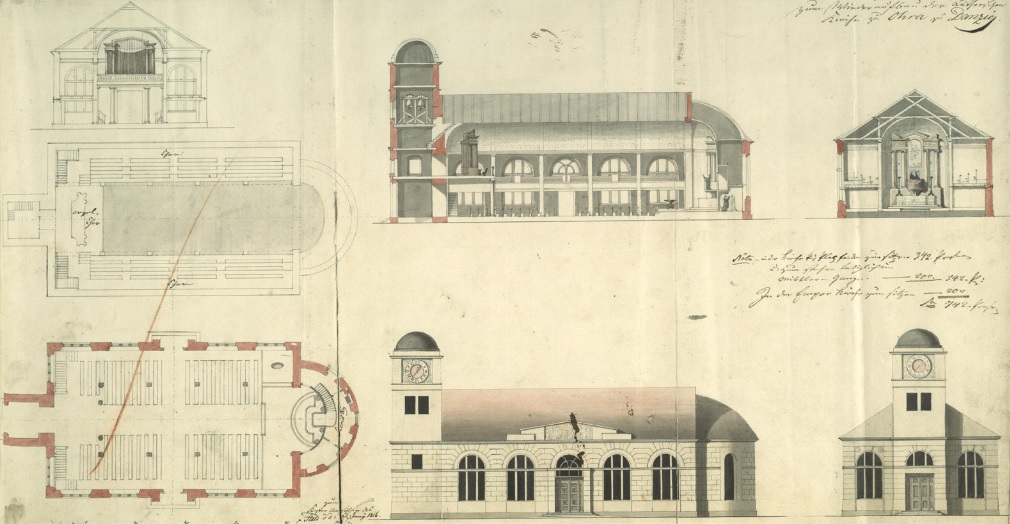Niezrealizowane projekty odbudowy kościoła w Oruni autorstwa gdańskiego architekta miejskiego Carla Samuela Helda
Słowa kluczowe:
architektura sakralna, klasycyzm, neogotyk, styl ok. 1800, kanzelaltar, Gdańsk, architekt miejski, zamek w Malborku, Carl Samuel HeldAbstrakt
This article discusses widely unknown designs of the Evangelical church in the village of Orunia near Gdańsk from 1816–1819. The concepts preserved in the State Archive in Gdańsk contain as many as eight variants of the reconstruction of the meeting house destroyed during a siege in 1813. The author of these concepts was the contemporary city architect Carl Samuel Held. As a student of Carl Gotthard Langhans (1732–1808), one of the greatest Prussian architects of that time, Held consistently used classicist forms throughout his body of work. His first two designs for the reconstruction of the church in question were in line with the so-called revolutionary classicism. The following six neo-Gothic variants constituted a formal exception in his oeuvre. Moreover, the case of the Orunia church was the only time he ever attempted to design a sacral building. The clumsiness in the use of neo-Gothic forms, as well as the inability to fit into the assumed financial framework contributed to the rejection of Held’s designs. Eventually, the project by August von Gersdorff verified by the head of the Higher Construction Deputy Karl Friedrich Schinkel was the one that was implemented. The construction was completed in 1823. The forms used in the building exhibit inspiration drawn from the Teutonic castle in Malbork. The prime mover behind their use was the Oberpräsident of the Province of West Prussia Theodor von Schön, promoter of the restoration work at the castle. The church in Orunia is the first case of a building with neo-Gothic features in Gdańsk and its area, as well as the first construction with forms intentionally referring to the Malbork Castle, a landmark symbolizing the essence of Germanity.
Downloads
Bibliografia
Arszyński Marian, Nowomiejski kościół ewangelicki w Toruniu. Przyczynek do dziejów architektury pierwszej połowy XIX wieku na Pomorzu, „Acta Universitatis Nicolai Copernici. Nauki Humanistyczno-Społeczne. Zabytkoznawstwo i Konserwatorstwo” 1994, t. 25, s. 172–173.
Bielak Jacek, Budowniczy miejski Carl Samuel Held i próby modernizacji Gdańska na przełomie XVIII/XIX wieku [w:] Gdańsk i okolice 1793–1914. Miasto – ludzie – wydarzenia w rysunku i grafice, red. Wojciech Bonisławski, Aleksander Baliński, Gdańsk 2014, s. 54–63.
Bielak Jacek, Städtisch oder staatlich? Das Danziger Städtische Gymnasium in den Jahren 1835–1837 [w:] Stadtkultur des späten Mittelalters und der frühen Neuzeit in Ostmitteleuropa und ihre Renaisance im 19. Jahrhundert / Kultura miast środkowoi wschodnioeuropejskich w późnym średniowieczu i renesansie oraz jej odrodzenie w XIX wieku, red. Marco Bogade, Warszawa 2012, s. 229–242.
Bielak Jacek, Tradycjonalizm w służbie państwa. Szkic z dziejów nowego gmachu Gdańskiego Gimnazjum Akademickiego [w:] Tradycjonalizm i neotradycjonalizm w sztuce XIX i XX wieku na Pomorzu, red. Józef Tarnowski, Roman Nieczyporowski, Gdańsk 2012, s. 87–117.
Birecki Piotr, Ewangelickie budownictwo kościelne w Prusach Zachodnich. Relacje między państwem a Kościołem ewangelicko-unijnym, Toruń 2014.
Börsch-Supan Eva, Karl Friedrich Schinkel. Die Provinzen Ost- und Westpreußen und Großherzogtum Posen, München–Berlin 2003.
Dargacz Janusz, Z dziejów gdańskich kąpielisk. Projekty Carla Samuela Helda dla Jelitkowa z 1801 roku [w:] Gdańsk i okolice 1793–1914. Miasto – ludzie – wydarzenia w rysunku i grafice, red. Wojciech Bonisławski, Aleksander Baliński, Gdańsk 2014, s. 65–70.
Driesch Michaela van der, Der „Gotische Turmaufsatz” der St. Maarienkirche in den Akten – ein Beispiel für Architektur und Fabre im Stadtraum Berlin um 1800 [w:] Neue Baukunst. Berlin um 1800, Hg. Elke Blauert, Katharina Wippermann, Berlin 2007, s. 105–115.
Friedrich Jacek, Walka obrazów. Przedstawienia wobec idei w Wolnym Mieście Gdańsku, Gdańsk 2018.
Grundmann Friedhelm, Carl Gotthard Langhans (1732–1808). Lebensbild und Architekturführer, Würzburg 2007.
Harnoch Agathon, Chronik und Statistik der evangelischen Kirchen in den Provinzen Ost- und Westpreussen, Neidenburg 1890.
Hinrichs Walther Th., Carl Gotthard Langhans. Ein schlesischer Baumeister 1733–1808, Strassburg 1909.
Keyser Erich, Die Baugeschichte der Stadt Danzig, Köln–Wien 1972.
Kos Jerzy Krzysztof, Carl Gotthard Langhans 1732–1808. Architekt z Kamiennej Góry, Kamienna Góra 2007.
Kos Jerzy Krzysztof, Der Weg nach Berlin… Carl Gotthard Langhans’ Tätigkeit in Schlesien 1760–1808 [w:] Deutsche Baukunst um 1800, Hg. Reinhard Wegner, Köln 2000, s. 65–92.
Kozina Irma, Aspekty stosowania pojęcia „historyzm” w badaniach nad architekturą niemiecką XIX wieku, „Rocznik Historii Sztuki” 1997, t. 23, s. 171–182.
Kozina Irma, Styl około 1800. Styl narodowy czy nowa rzeczywistość w architekturze Górnego Śląska? [w:] Nacjonalizm w sztuce i historii sztuki 1789–1950, red. Dariusz Konstantynów, Robert Pasieczny, Piotr Paszkiewicz, Warszawa 1998, s. 171–182.
Krause Waldemar, Das Danziger Theather und sein Erbauer Carl Samuel Held, Danzig 1936.
Maciakowska Zofia, Szymański Wojciech, Akta Policji Budowlanej jako materiał do studiów nad gdańską kamienicą mieszczańską od średniowiecza do początku XIX wieku [w:] Dom w mieście średniowiecznym i nowożytnym, red. Bogusław Gediga, Wrocław 2004, s. 249–276.
Maciakowska Zofia, Szymański Wojciech, Dokumentacja Urzędu Policji Budowlanej w Gdańsku jako źródło do badań nad dawnymi kamienicami [w:] Studia i materiały do dziejów domu gdańskiego, cz. 1, red. Edmund Kizik, Gdańsk 2009, s. 207–223.
Mebes Paul, Um. 1800. Architektur und Handwerk im letzten Jahrhundert ihrer traditionellen Entwicklung, München 1908.
Muhl John, Die Kirche und Schule in Ohra, „Weichselland” 1942, No. 41, s. 40–45.
Ostrowska-Kębłowska Zofia, Architektura i budownictwo w Poznaniu w latach 1780–1880, Poznań 1982.
Philipp Klaus-Jan, Randez-vous bei Boullée. Pariser Architektur im Urteil deutscher Architekten um 1800 [w:] Deutsche Baukunst um 1800, Hg. Reinhard Wegner, Köln 2000, s. 109–128.
Rüsch Eckart, Baukonstruktion zwischen Innovation und Scheiter. Verona, Langhans, Gilly und die Bohlendacher um 1800, Petersberg 1997.
Samp Jerzy, Orunia, Stare Szkoty i Lipce, Gdańsk 2005.
Schmid Bernhard, Die Denkmalpflege in Westpreussen 1804–1910, Danzig 1910.
Schmid Bernhard, Oberpräsident von Schön und die Marienburg, Halle 1940.
Velin Regulus, Der Baumeister des Brandenburger Tores. Historiographisches über den Architekten Carl Gotthard Langhans, Berlin 1983.
Waage Ernst Wilhelm, Ausführliche Geschichte Ohra’s eines Dorfes im Danziger Landraths-Kreise, Regierungsbezirks Danzig, Danzig 1859.
Wessel Max, Die Organisation der Polizei in der Stadt Danzig und in ihrem Hafen nach Einverleibung derselben in die preußische Monarchie, Danzig 1905.


 Uniwersyteckie Czasopisma Naukowe
Uniwersyteckie Czasopisma Naukowe



